The kitchen, a hub of activity and one of the largest consumers of energy in the home, stands out as a prime candidate for energy-saving updates. Whether it’s through the use of electricity for cooking and refrigeration or water for cleaning, the kitchen’s energy demand is unparalleled. By focusing on energy-efficient improvements, homeowners in Cleveland can transform their kitchens into models of sustainability and efficiency. This guide dives into the essential energy-efficient stats and strategies that not only reduce your carbon footprint but also lead to significant savings on utility bills. From the latest in energy-efficient LED lighting to cutting-edge appliances, discover how your kitchen remodel can contribute to a greener planet and a more cost-effective home.
Table of Contents
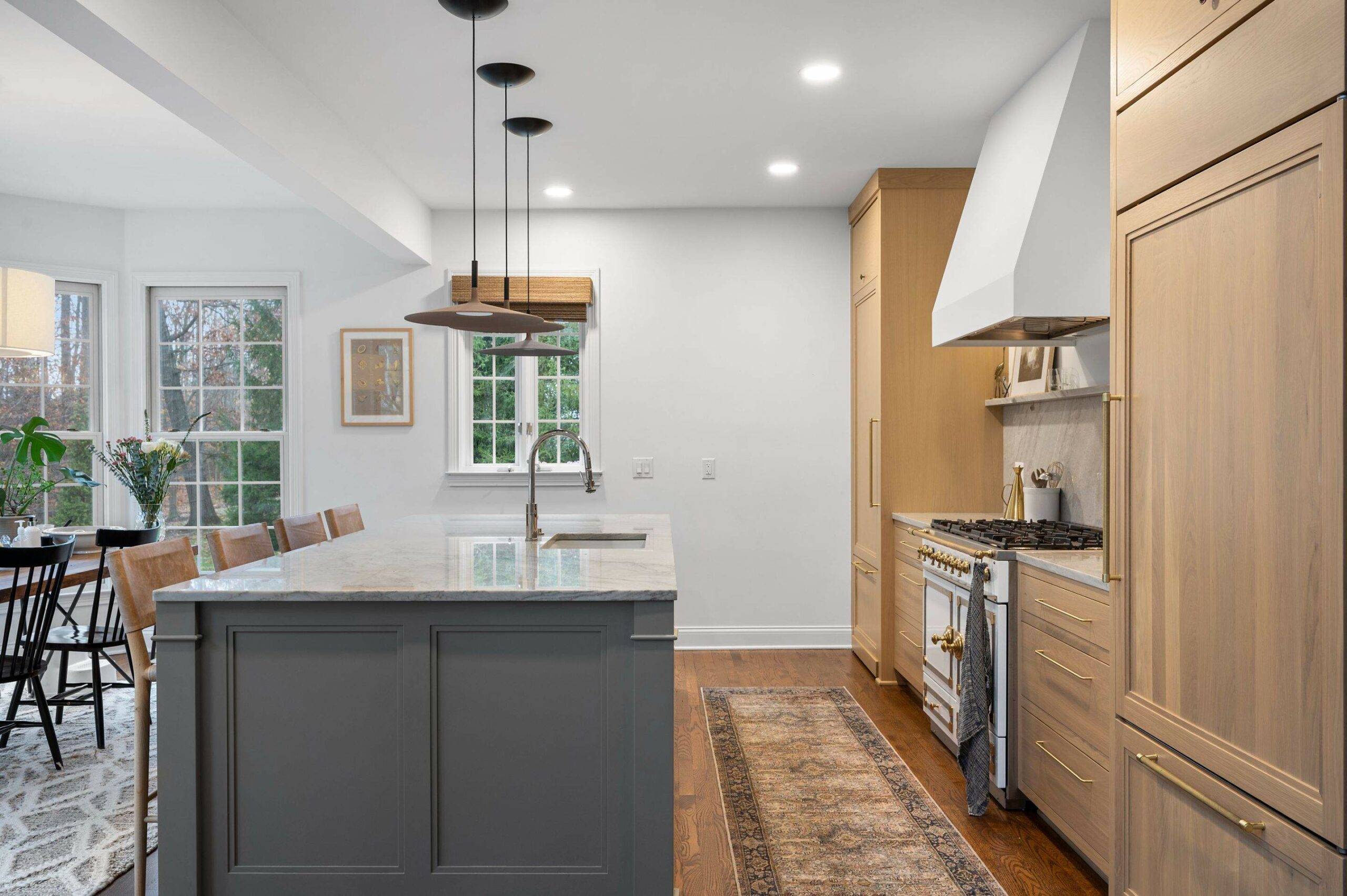
The Energy Efficient Kitchen – The Cost of Electricity in Cleveland
In Ohio, our average residential electricity cost is around 15.69 cents per kWh (Kilowatthour) as of late 2023 according to the US Energy Information Administration power usage. This figure is crucial for Cleveland residents to manage their energy usage and budget effectively. For the most accurate local rates, reference your most recent electric bill. This number will help you determine how much you could be saving in electrical expense in one of the highest energy consuming rooms in your house – your kitchen. However, it is also important to remember that even if you have a low cost per kWh, the energy consumed has a direct impact on our environment so energy efficiency is still a critical concern for the modern home. The question then becomes, how do I determine the electrical consumption in my kitchen and how can I improve efficiency? Let’s get started.
“In Ohio, the average residential electricity cost is around 15.69 cents per kWh as of late 2023.”

According to the US home and census region in 2020, the average single-family detached home in the midwest consumes the highest energy at 15,150 kWh annually. (Note: if you live in Cleveland and you were looking at the blue, “Northeast” bar on the chart, think again. According to the US Census Bureau, you indeed live in the midwest.) Given the $0.1569 /kWh cost, that translates to $2,377 per year in Ohio. This statistic highlights a baseline for energy use, underscoring the variance expected across different households. Specifically, larger homes tend to have higher energy demands due to increased space for heating, cooling, and lighting. Consequently, while this average offers a general understanding, actual consumption will vary, influenced by factors such as house size, energy efficiency measures in place, and individual lifestyle choices.
“The average single-family detached home in the midwest consumes 15,150 kWh annually… this translates to $2,377 per year in Ohio.”
Although reducing our energy consumption is still a critical concern to the conscientious homeowner, it is important to note that Ohio has been making excellent strides toward reducing greenhouse gas emissions in the past decade, especially in the realm of electricity generation. The transition from coal to natural gas, which emits fewer greenhouse gases, has significantly contributed to this effort. By 2022, natural gas fueled over half of Ohio’s electricity, while coal’s share dropped to 37%, a substantial decrease from 82% in 2010. This shift, along with contributions from nuclear power and renewable resources like wind, marks Ohio’s commitment to a cleaner energy future according to the US Energy Information Administration. That leads us to the next topic, natural gas.
“By 2022, natural gas fueled over half of Ohio’s electricity, while coal’s share dropped to 37%, a substantial decrease from 82% in 2010.”
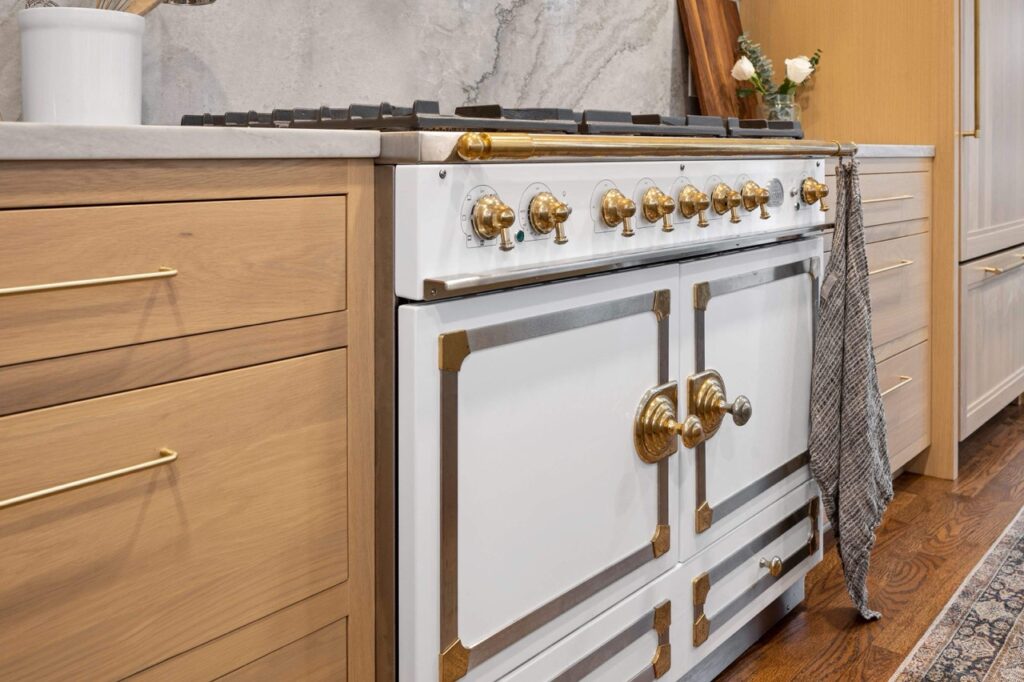
Cleveland Natural Gas Stats in the Kitchen
Electricity isn’t the sole focus when it comes to home energy efficiency; natural gas plays a crucial role as well. In regions like Cleveland, where natural gas is commonly used for heating, cooking, and water heating, opting for efficient natural gas appliances can significantly reduce energy consumption and costs. By understanding and choosing high-efficiency natural gas options, homeowners can achieve a more sustainable, cost-effective energy solution for their homes, complementing their electrical efficiency efforts.
According to research done by NOPEC, the average price for natural gas in the greater Cleveland area is approximately $9.02 per Mcf (thousand cubic feet), which is roughly 20% lower than the national average of $10.84 per Mcf. The average household in Cleveland spends $76.67 / mo on natural gas and $920 /year.
“The average price for natural gas in the greater Cleveland area is approximately $9.02 per Mcf… the average household in Cleveland spends roughly $920 per year on natural gas.”
In Ohio, it’s important to note that a large portion of your gas bill, if you use natural gas heating in your home, is attributed to heating costs. In the Midwest, around two-thirds of residences rely on natural gas for heating. The good news is that in 2024 the Energy Information Administration (EIA) predicts that the total winter heating cost will be approximately $581, marking a 21% decrease compared to the previous year according to The Columbus Dispatch. However, your other home appliances do have an impact. Let’s look at oven ranges.
Selecting an oven range for your kitchen remodel involves considering efficiency alongside functionality and style. Energy-efficient models not only reduce utility bills but also support environmental sustainability. Look for ovens with Energy Star ratings, which signify higher efficiency standards. Additionally, consider models with convection cooking, as they circulate hot air to cook food more evenly and quickly, saving energy. Induction cooktops are another efficient option, using electromagnetic energy to directly heat pans, reducing heat loss. Balancing these features with your cooking needs and budget will ensure you choose an oven range that enhances your kitchen’s efficiency and appeal. For a kitchen remodel, duel fuel options are becoming popular since they join the efficiencies of electric and natural gas like the BlueStar® Dual Fuel Range Series.
“The Energy Information Administration (EIA) predicts that the total winter heating cost will be approximately $581, marking a 21% decrease compared to the previous year.”
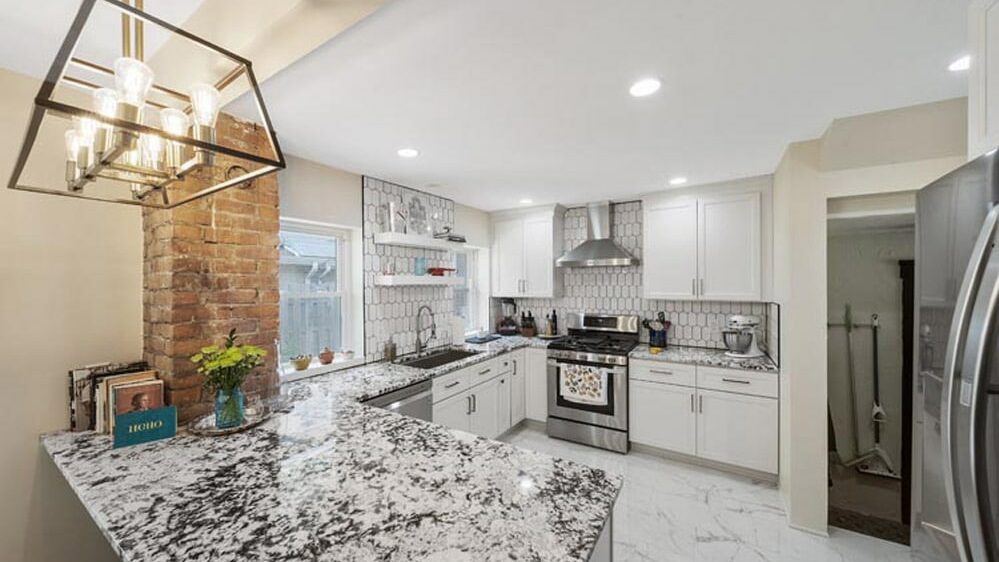
Kitchen Lighting Efficiency – Crafting the Perfect Lighting Ambiance
Lighting accounts for around 15% of an average home’s electrical use according to energy.gov; this makes optimizing kitchen lighting a key step in energy-efficient remodeling. If you have not completely switched over already, exclusively using LED bulbs can save at least 75% energy and last 25 times longer than traditional bulbs according to this article by energy.gov. The average single family home in America has 85 lights in the house. This means if the average home switches from a 60 Watt bulb to a 8.5 Watt LED, they could save 4.378 kW. If you leave your lights on for 16hrs a day, those savings would equal $10.99 / day for just switching to LEDs!
“Exclusively using LED bulbs can save at least 75% energy and last 25 times longer than traditional bulbs.”
For modern kitchens aiming for a bright and energy-efficient ambiance, incorporating recessed LED lighting is often recommended. This setup ensures comprehensive and even illumination across the kitchen. To add distinctiveness and a decorative element, selecting LED pendant lights that align with your personal style and the kitchen’s design theme can enhance the space’s character and appeal.

Windows and Skylights – Several Benefits to Natural Lighting
While we are on the topic of lighting, let’s talk about windows and skylights and how they can assist with our energy savings in the kitchen. In the past few years since 2020, the increase in remote work has meant more people are home during the day, which presents a unique opportunity to leverage natural lighting and cut down on energy consumption. Utilizing daylight through strategic placement of windows and skylights can significantly reduce the need for artificial lighting.
In Cleveland, where the sun sometimes seems as elusive as a good parking spot downtown, utilizing skylights and large kitchen windows can still shave significant figures off your energy bills. Even with the city’s famously fickle weather, the infusion of natural light helps cut down on the need for electric lighting. The energy-efficient windows add to the savings by enhancing indoor temperature regulation, proving that every cloud—or lack thereof—indeed has a silver lining. According to BestPlaces.net, in Cleveland we enjoy 166 sunny days per year on average – we will take all the natural light we can get!
“In Cleveland we enjoy 166 sunny days per year on average – we will take all the natural light we can get!“
This approach not only reduces electricity consumption but also offers mental health benefits. Natural light is known to boost mood, increase productivity, and improve sleep by regulating circadian rhythms according to this research paper that examines the impact of daylight exposure on overall health. Thus, making the most of daylight in your kitchen can contribute to both a reduction in energy costs and an enhancement in overall well-being.
“Natural light is known to boost mood, increase productivity, and improve sleep by regulating circadian rhythms.”
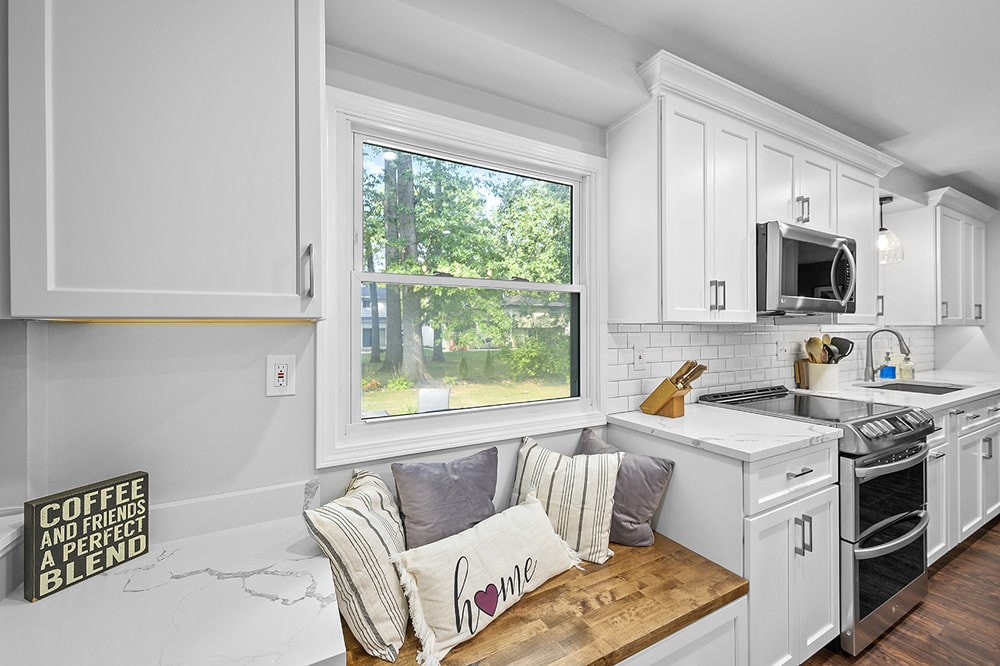
Updating Your Kitchen Windows – Insulation Efficiency
When it comes to kitchen renovations, homeowners often focus on aesthetics—choosing the right countertops, cabinetry, and fixtures to match their vision. However, an aspect just as crucial, yet frequently overlooked, is the energy efficiency of kitchen windows. Upgrading to energy-efficient windows not only enhances the visual appeal of your kitchen but also plays a significant role in reducing energy bills, improving comfort, and contributing to a more sustainable home environment. In this article, we delve into the importance of updating your kitchen windows for insulation efficiency, exploring the benefits, considerations, and the latest advancements that make modern windows essential components of any eco-friendly kitchen makeover.
According to the US Department of Energy’s article on window upgrades, homeowners can save “7%-15% on annual household energy bills, or roughly $71-$501 annually, depending on your geographic location and the type of window being replaced.” Given that the average life span of a window is around 20 years according to this article by Forbs Home, this means the energy savings alone could be between $1,420 – $10,020 over the course of 20 years with upgraded windows.
“With updated windows, homeowners can save 7%-15% on annual household energy bills, or roughly $71-$501 annually, depending on your geographic location and the type of window being replaced.”
Understanding the different types of windows in terms of efficiency is key to selecting the best option for your kitchen renovation. Here’s a closer look at the various window types:
- Single-Pane Windows: These are the most basic form of windows, consisting of a single layer of glass. They offer minimal insulation and are less efficient compared to more modern designs. Single-pane windows are typically found in older homes and are a major source of energy loss. If your kitchen still has single-pane windows, it is definitely time to Refresh Your Cleveland Kitchen.
- Double-Pane Windows: A significant step up in terms of insulation, double-pane windows consist of two layers of glass with an air or gas-filled space between them. This design greatly reduces heat transfer, making your kitchen more energy-efficient by maintaining a consistent indoor temperature more effectively than single-pane windows.
- Triple-Pane Windows: For maximum energy efficiency, triple-pane windows incorporate three layers of glass and two air or gas-filled spaces. This type offers the highest level of insulation, making them ideal for extreme climates. They can significantly reduce energy bills and improve comfort in your kitchen.
- Low-Emissivity (Low-E) Windows: These windows have a microscopically thin coating that reflects infrared and UV light, keeping heat inside during winter and outside during summer. Low-E coatings can be applied to any pane window type, enhancing their energy efficiency without affecting the amount of visible light that passes through.
- Gas-Filled Windows: Often found in double and triple-pane windows, inert gases like argon or krypton are used between the panes instead of air. These gases are better insulators and further reduce heat transfer through the window.
- Energy-Efficient Frames: The material of the window frame also affects energy efficiency. Vinyl, wood, fiberglass, and composite frames offer better insulation compared to traditional aluminum frames.
Your windows might need replacing if you experience drafts, difficulty operating the window, condensation between panes, or noticeable energy bills increase. Also, if your kitchen still has single-pane windows, or they are over 20 years old, it is time to replace those windows. Upgrading to a more energy-efficient model will likely result in significant energy savings and improved comfort. If you are considering a kitchen remodel, consider reading our top 6 remodeling challenges to overcome for a smooth remodeling experience.
“If your kitchen still has single-pane windows, or they are over 20 years old, it is time to replace those windows.”
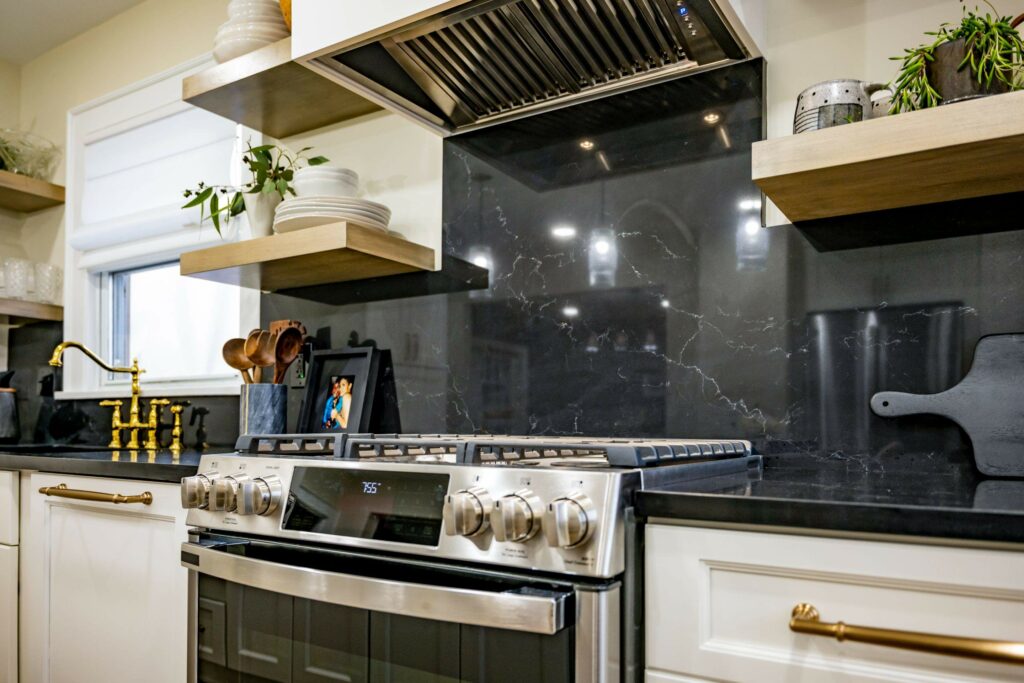
Recap
This guide explored essential considerations for an energy-efficient kitchen remodel, emphasizing the significance of selecting the right lighting, window upgrades, and energy-saving appliances. It highlighted the importance of balancing aesthetic preferences with functional and sustainable choices to enhance the kitchen’s energy efficiency, ultimately contributing to lower utility costs and a reduced environmental impact.
At Keselman Group, with our team of skilled designers, can assist homeowners in the Cleveland area to design and create an elegant and energy-efficient kitchen. Our expertise in modern remodeling practices ensures that every aspect of your kitchen, from lighting to appliances, is chosen with energy efficiency in mind.
Contact us today for a free estimate on your kitchen remodel. If you are looking for more inspiration, checkout our article on 7 Modern Kitchen Design Trends we are seeing.


